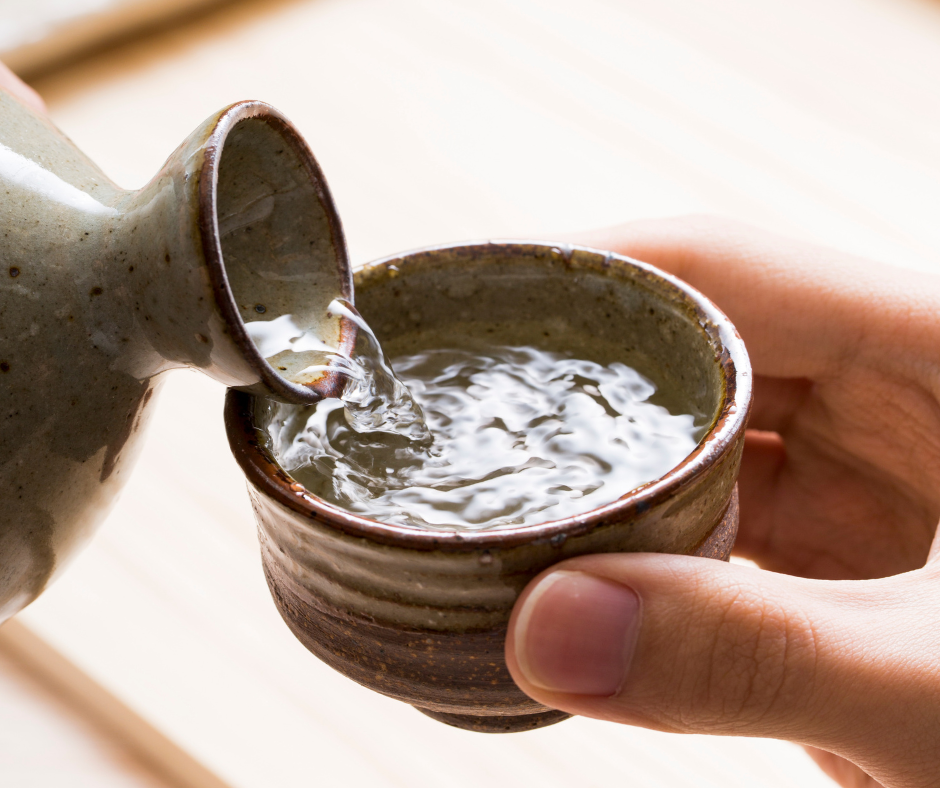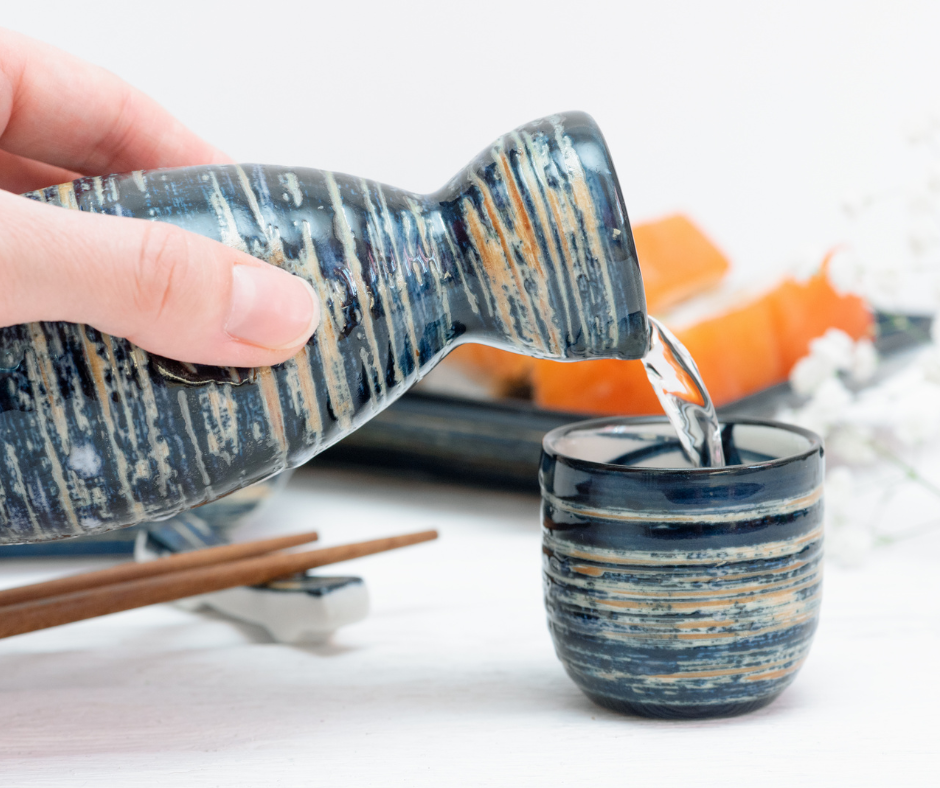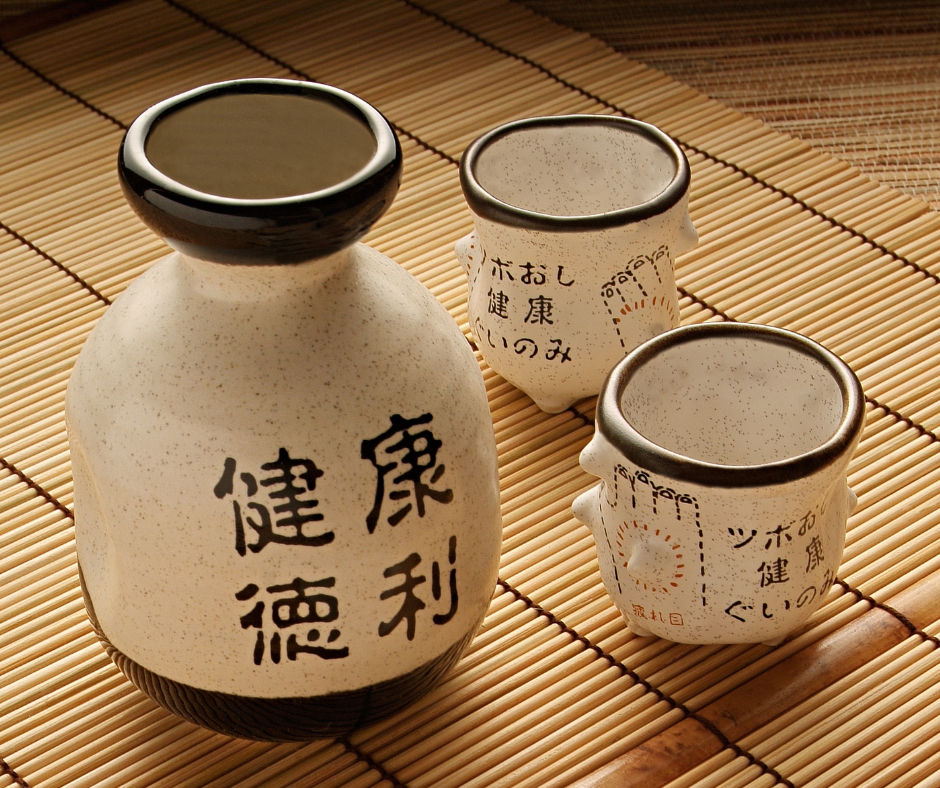Introduction
Discover the art of warming Sake and unlock the magic within this traditional Japanese beverage. Sake, a rice wine with a rich history and cultural significance, can be elevated to new heights when served at the perfect temperature. In this guide, we will explore the importance of properly heating sake and provide tips on How to Heat Sake and enhance your sake-sipping experience.
The Magic Of Properly Warmed Sake
Heating sake can transform its flavor profile and reveal subtle nuances that may go unnoticed when served cold. You can enhance its aromatic qualities by warming Sake and creating a more delicate and rounded taste. Warm Sake is soothing, making it an ideal choice during colder months or when you desire a comforting drink.
Importance Of Heating Sake The Right Way
Heating sake correctly is crucial to preserving its delicate flavors and ensuring a harmonious balance. Here are some key reasons why it’s important:
- Optimal Temperature: Different types of Sake require specific temperatures for the best flavor. Heating sake too much or too little can mask its true essence. By understanding the recommended temperatures for different sake varieties, you can bring out the best in each bottle and truly appreciate their unique characteristics.
- Enhanced Aromas: Warming Sake unlocks its aromatic profile, allowing the complex notes of fruity, floral, and rice-forward scents to develop fully. This enhances the overall enjoyment and sensory experience when sipping Sake.
- Smooth Texture: Properly warmed Sake exhibits a smooth and velvety texture on the palate. The gentle heat enhances the Sake’s mouthfeel, creating a delightful sensation as it glides across your tongue.
- Tradition and Culture: Warming sake is deeply rooted in Japanese tradition and culture. By embracing this practice, you respect the beverage’s heritage and gain a deeper understanding of its significance in Japanese rituals and celebrations.
Through the art of heating sake, you can elevate your sake-sipping experience and fully appreciate the depth and complexity of this cherished beverage. With the right knowledge and techniques, you can unlock warmed Sake’s true magic and allure. Stay tuned for the next section, where we will delve into the different methods and temperatures for heating sake to perfection.

How to Heat Sake: Methods Of Warming Sake
You can choose from a few different methods when it comes to warming Sake. Each method has unique benefits and can contribute to the overall experience of sipping Sake. Here, we will explore two popular methods: the traditional method using a tokkuri or heat-proof vessel and an alternative method using a mason jar or other containers.
Traditional Method Using A Tokkuri Or Heat-proof Vessel
The traditional method of warming sake involves using a tokkuri, a heat-proof ceramic or glass vessel specifically designed for serving Sake. This method allows for precise temperature control and ensures that the Sake is heated evenly. To learn How to Heat Sake using this method, follow these steps:
- Fill the tokkuri with Sake to about 70-80% full. It is important not to fill it to the brim to allow space for expansion when heated.
- Place the tokkuri in a hot water bath or a specialized sake warmer. The temperature of the hot water bath or Sake warmer should be set according to the type of Sake you are warming. Generally, it is recommended to heat junmai and honjozo sake to around 40-45 degrees Celsius (104-113 degrees Fahrenheit) and ginjo and daiginjo sake to around 35-40 degrees Celsius (95-104 degrees Fahrenheit).
- Allow the Sake to warm for a few minutes. Gently swirl the tokkuri to ensure even heating and to release any trapped air bubbles.
- Test the temperature by pouring some sake into a choko, a small ceramic, or a glass cup. Sip the Sake and adjust the temperature accordingly. If it is too hot, allow it to cool slightly. If it is not warm enough, return the tokkuri to the hot water bath or Sake warmer.
- Once the Sake reaches the desired temperature, it will be enjoyed. Serve it in small portions and savor the flavors as they unfold with each sip.
Alternative Method: Using A Mason Jar Or Other Containers
If you don’t have a tokkuri or prefer a more improvisational approach, you can also heat Sake using a mason jar or other heat-proof containers. Here’s How to Heat Sake using this method:
- Pour Sake into a clean, heat-proof container like a mason jar or ceramic teacup. Like the traditional method, fill the container to about 70-80%.
- Place the container in a pot with water, creating a water bath that will heat the Sake indirectly. Ensure the water level is below the container’s rim to prevent any water from entering the Sake.
- Heat the pot slowly over low to medium heat. Avoid high heat, which can cause the Sake to heat unevenly or even boil, altering its flavors.
- Stir the Sake occasionally to ensure even heating and to release any trapped air bubbles.
- Test the temperature using the same method as with the traditional method. Adjust the heat as necessary until the Sake reaches the desired temperature.
- Once the Sake is heated to your liking, remove the container from the water bath and serve the Sake in ceramic or glass cups.
Both methods offer a unique way of warming Sake, allowing you to experiment and find the best method. Regardless of your chosen method, it’s important to remember that warming sake should be done gently and carefully to preserve its delicate flavors. So grab your tokkuri or improvise with a mason jar and embark on a journey to master the art of warming sake. Cheers!
Temperature Guide
Exploring Different Temperatures For Different Flavors
When learning How to Heat Sake, the temperature at which it is served can greatly impact its flavors and aromas. Different temperatures bring out different characteristics in Sake, allowing you to explore and appreciate its nuances. Here is a temperature guide to help you navigate the world of warmed Sake:
- Room Temperature (15-20 degrees Celsius / 59-68 degrees Fahrenheit): Sake served at room temperature showcases its natural flavors and aromas without any adjustments. This ideal temperature is for delicate and fruity sakes, allowing their subtle nuances to shine.
- Slightly Warm (30-40 degrees Celsius / 86-104 degrees Fahrenheit): Slightly warming Sake enhances its umami flavors and brings out its smoothness. This temperature range suits various sake types and can accentuate their characteristics.
- Warm (45-50 degrees Celsius / 113-122 degrees Fahrenheit): Warmer temperatures intensify the flavors and bring out a rich, full-bodied profile. This is well-suited for sakes with robust and bold flavors.
- Hot (55-60 degrees Celsius / 131-140 degrees Fahrenheit): Hot Sake exhibits strong flavors and can be enjoyed as a warm beverage. However, it’s important to note that the higher the temperature, the more the alcohol content becomes prominent, potentially overshadowing other flavors.
Using A Thermometer To Achieve Desired Warmth
To achieve the desired temperature for your Sake, using a thermometer can be a helpful tool. Insert the thermometer into the Sake to accurately measure its temperature. This ensures you can serve your Sake at the perfect warmth, enhancing its flavors and aromas.
Remember that experimenting with different temperatures is encouraged, as it allows you to discover the flavors that appeal to your palate. Some sakes may shine when served slightly warm, while others are best enjoyed at room temperature. The key is to find the temperature that brings out the best in each Sake and enhances your overall drinking experience.
So indulge in the art of warming sake and savor the rich flavors and aromas this traditional Japanese beverage offers. Cheers!

Tips And Tricks
Mastering the art of warming sake is a delightful journey that enhances the flavors and aromas of this traditional Japanese beverage. While the traditional method using a tokkuri or heat-proof vessel and the alternative method using a mason jar or other containers are the most popular ways to warm Sake, here are a few additional tips and tricks when learning How to Heat Sake to elevate your sake warming experience further.
Preparing Sake Cups For Light Warming
The vessel you use plays a crucial role in warming Sake. To prepare sake cups for light warming, follow these simple steps:
- Select the right cups: Choose ceramic or glass cups that withstand gentle heat. It’s important to avoid using cups with delicate materials or coatings that may melt or alter the Sake’s flavors.
- Warm the cups: Wash them with hot water before pouring the warmed Sake. This step ensures that the cups are at an optimal temperature, allowing the Sake to maintain its warmth longer.
- Avoid overheating: While light warming can enhance the Sake’s flavors, it’s crucial not to overheat the cups. Aim for a gentle, subtle warmth that complements the Sake rather than overpowering it.
Using The Microwave As A Quick Alternative
If you’re looking for a quick and convenient way to warm Sake, you can utilize the microwave as an alternative method. However, this method should be used cautiously to prevent overheating or altering the Sake’s delicate flavors. Here’s how you can heat Sake using a microwave:
- Pour Sake into a microwave-safe container: Select a microwave-safe vessel, preferably a heat-resistant glass or ceramic cup.
- Warm the Sake: Place the container in the microwave and heat it on low power for 15 to 30 seconds per round. This approach helps prevent the Sake from becoming too hot too quickly.
- Stir and test the temperature: Gently stir the Sake after each interval to ensure even heating. Test the temperature by pouring a small amount into a sake cup and adjusting the heating time accordingly.
- Exercise caution: It’s important to monitor the Sake to prevent overheating or boiling closely. Never leave the microwave unattended while warming the Sake, as the heating time may vary depending on the Sake’s initial temperature and the power of your microwave.
While the microwave method offers a quick alternative for warming’s Sake, it’s worth noting that it may not provide the same level of precision and control as the traditional or Mason jar methods. Therefore, using this method sparingly and only temporarily when a heat-proof vessel is unavailable is recommended.
Remember, the key to mastering the art of warming Sake lies in finding the method that suits your preferences and allows the Sake’s subtle flavors to shine. Whether you choose the traditional method, the mason jar improvisation, or even the microwave alternative, these tips and tricks will help you elevate your sake-warming experience and savor the rich aromas and flavors of this time-honored Japanese beverage. Cheers!
Personal Experiences And Recommendations
Sharing Experiences From Koji Club Members
Heating sake is not just a technique; it’s an art that can enhance the flavors and aromas of this traditional Japanese beverage. The members of Koji Club, a community of sake enthusiasts, have shared their personal experiences and recommendations for warming Sake. One member, Hiroshi, suggests using a traditional tokkuri, a heat-proof vessel, to warm Sake. He believes that using the right vessel can preserve the Sake’s delicate flavors and maintain its warmth for a longer time.
Another member, Aiko, prefers a slightly different approach. She suggests using a mason jar as an alternative method for warming Sake. Aiko loves the versatility of this method, as it allows her to warm Sake quickly and conveniently without compromising the taste. She recommends placing the mason jar in a warm water bath for a few minutes to slowly heat the Sake, ensuring it doesn’t become too hot too quickly.
Unique Methods And Tools For Warming Sake
In addition to the traditional and mason jar methods, there are some unique methods and tools you can explore to elevate your sake-warming experience further. One such method is using a specialized sake warmer. These devices are designed specifically for warming Sake and provide precise temperature control, ensuring that the Sake is heated to perfection.
If you prefer a more hands-on approach, try using a warm bath or hot sand to warm the Sake. These methods involve placing the sake bottle or tokkuri in a warm bath or burying it in hot sand to heat the Sake slowly. This gradual warming process allows the flavors to develop, creating a rich and complex taste.
For those who enjoy experimentation, there are even sake-warming stones available. These stones are heated and then placed in the Sake to warm them from within, providing a unique and customized warming experience.
Regardless of your chosen method or tool, it’s important to remember a few key tips. First, avoid overheating the Sake to preserve its delicate flavors. Aim for a gentle, subtle warmth that complements the Sake rather than overpowering it. Second, always use heat-proof vessels and tools to ensure the safety and quality of the Sake.
In conclusion, personalized experiences and unique methods can add a touch of creativity to your sake warming journey. By exploring different techniques and tools, you can discover the method that suits your preferences and allows the Sake’s subtle flavors to shine. Remember to experiment, share experiences with fellow enthusiasts, and, most importantly, savor this time-honored Japanese beverage’s rich aromas and flavors. Kanpai!

Conclusion
Now you should know How to Heat Sake. Mastering the art of warming sake is not just a technique; it is an opportunity to enhance the flavors and aromas of this traditional Japanese beverage. By exploring different methods and tools and embracing the diverse flavors and aromas of heated Sake, you can elevate your sake-sipping experience to new heights.
Importance Of Mastering The Art Of Warming Sake
Understanding how to properly warm Sake is crucial to fully appreciating its subtle nuances and complexities. As with any beverage, serving Sake at the right temperature can significantly impact its taste and aroma. By mastering the art of warming sake, you can unlock its full potential and create an enjoyable drinking experience.
Embracing The Diverse Flavors And Aromas Of Heated Sake
Warming Sake not only helps to bring out its flavors and aromas but also allows you to explore a range of tastes. Depending on your chosen method, you can achieve different levels of warmth, from slightly warm to hot. Each temperature highlights different characteristics of the Sake, offering a diverse range of flavors and aromas for you to savor.
Whether you prefer the traditional method of using a tokkuri, the convenience of a mason jar, or the precision of a specialized sake warmer, various techniques and tools are available to experiment with. The key is to find the method that suits your preferences and allows the Sake’s subtle flavors to shine.
As you embark on your sake-warming journey, remember to share your experiences with fellow sake enthusiasts, exchange recommendations, and embrace the creativity of trying different techniques. Explore the rich history and cultural significance of sake warming, and most importantly, savor the unique aromas and flavors this time-honored Japanese beverage has to offer. Kanpai!
FAQ: How to Heat Sake – Sake Sips: Mastering the Art of Warming Your Sake
Q: Which types of Sake are commonly heated?
A: Two often heated types of Sake include junmai and honjozo. Junmai sake is often served fairly warm to hot, while honjozo sake is typically served warm at room-to-body temperature.
Q: Can I heat Sake in a microwave?
A: Yes, you can heat sake in a microwave. Pour your Sake into a glass or ceramic container that is microwavable.
Q: How to Heat Sake on the stove?
A: To heat Sake on the stove, pour the Sake into a tokkuri or decanter. It’s important not to fill the container to the brim. Put some plastic wrap over the top to retain flavor and assist in heating. Transfer the Sake into a tokkuri once heated, then serve as usual.
Q: Why do some people prefer heated Sake?
A: Heating sake can help balance the acidic flavor with the sweet undertones more evenly, especially for sakes with high acidity. Additionally, warm Sake tends to taste drier than chilled Sake. The heating process also increases the effect of the alcohol as vapors begin coming off.
Q: How do I determine the right temperature to heat Sake?
A: You can heat Sake to a full range of temperatures, ranging from lukewarm to hot. It ultimately depends on your personal preference. Experiment with different temperatures to find the one that suits you best.
Remember, use proper techniques and appropriate containers to retain flavor and heat when heating sake. Cheers to mastering the art of warming your Sake!

Andre Lotz immigrated to the United States from South Africa almost 20 years ago. Still, he didn’t feel truly at home until he settled in Mobile—a city that reminds him of his childhood home of Fish Hoek on the southern cape of Africa.

